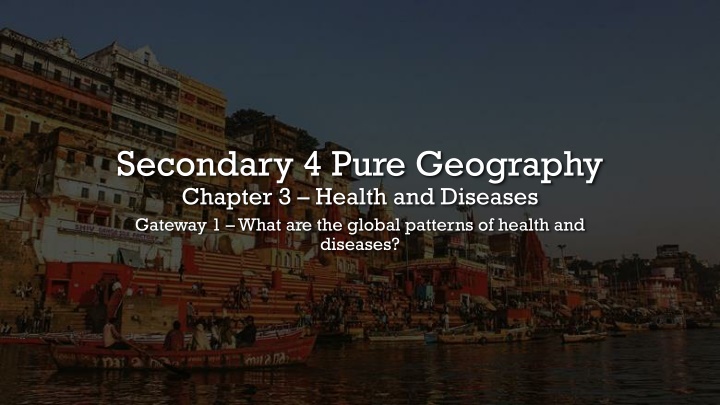Secondary 4 Pure Geography
This content delves into the global patterns of health and diseases, focusing on indicators such as infant mortality rate and life expectancy. It explores how the health of people differs between Developed Countries (DCs) and Less Developed Countries (LDCs), highlighting factors like social, economic, and environmental influences. The discussion sheds light on common diseases that cause more deaths in DCs and LDCs, providing valuable insights into understanding health disparities worldwide.
Download Presentation

Please find below an Image/Link to download the presentation.
The content on the website is provided AS IS for your information and personal use only. It may not be sold, licensed, or shared on other websites without obtaining consent from the author.If you encounter any issues during the download, it is possible that the publisher has removed the file from their server.
You are allowed to download the files provided on this website for personal or commercial use, subject to the condition that they are used lawfully. All files are the property of their respective owners.
The content on the website is provided AS IS for your information and personal use only. It may not be sold, licensed, or shared on other websites without obtaining consent from the author.
E N D
Presentation Transcript
Secondary 4 Pure Geography Chapter 3 Health and Diseases Gateway 1 What are the global patterns of health and diseases?
Gateway 1 What are the global patterns of health and diseases? a. What are the indicators used to measure health? b. How and why does the health of people differ between DCs and LDCs? c. Which diseases cause more deaths in DCs and LDCs?
What are the indicators used to measure health? Commonly used indicators to measure health include infant mortality rate and life expectancy.
Indicators to measure Health Infant Mortality Rate Infant mortality rate (IMR) refers to the number of deaths of children under the age of 1 year per 1000 live births in a particular year. Generally, DCs have a lower IMR than LDCs. IMR is low in DCs because of good standards of living (e.g. clean water supply). Most LDCs have high IMR due to poor access to healthcare, clean water supply etc. However, some LDCs like Thailand have low IMRs.
Indicators to measure Health Life Expectancy Life expectancy refers to the actual number of years a person can expect to live in a particular year. It reflects the overall level of a country. High life expectancy of 80 years and above is generally found in DCs. Low life expectancy of below 50 years is generally found in Sub-Saharan African countries. High Life Expectancy Generally in DCs (e.g. Singapore, Sweden, Japan) Low Life Expectancy Generally in Sub-Saharan Africa (e.g. Afghanistan, Chad, DR Congo)
Gateway 1 What are the global patterns of health and diseases? a. What are the indicators used to measure health? b. How and why does the health of people differ between DCs and LDCs? c. Which diseases cause more deaths in DCs and LDCs?
How and why does the health of people differ between DCs and LDCs? The variations in health of people in DCs and LDCs are due to a number of factors. Social Factors Diet Lifestyle Choices Education Economic Factors Poverty and Affluence Investment in Healthcare and Access to Health Services Environmental Factors Living Conditions Access to Safe Drinking Water Proper Sanitation
Social Factors Diet People in DCs tend to consume more meat, fruits and vegetables. They generally work in secondary and tertiary industries, earning higher incomes and have higher purchasing power. They have sufficient nutrients and are healthier. People in LDCs consume more starchy staples which lack nutrients, vitamins and minerals. They consume staples as they are cheaper and more affordable. As such, many especially in Sub-Saharan Africa are undernourished. Those who have an imbalanced nutrient intake are malnourished.
Social Factors Lifestyle Choices Lifestyle choices can influence one s health. A healthy lifestyle reduces the risk of many diseases including heart disease, diabetes and depression. This lifestyle includes physical activity such as sufficient exercise and daily activities like walking and doing housework.
Social Factors Lifestyle Choices For example, although cigarette smoking is declining worldwide, the industry is thriving in LDCs, especially in Indonesia. As of 2018, about 75% Indonesians are addicted to cigarettes. As such, cigarettes claim the lives of over 300,000 Indonesians annually. Furthermore, the smoking problem has led to a rise in heart diseases etc. Indonesia is one of the world s biggest producers of tobacco. Undoubtedly, it also has a large number of smokers as well.
Social Factors Education Educated people generally earn higher incomes and have greater access to healthcare, nutritious food and hygienic living conditions. DCs have high literacy rates. LDCs have low literacy rates especially female literacy. The large number of education-denied females especially in Sub-Saharan Africa not only lack knowledge on nutrition and hygiene in bringing up children.
Economic Factors Poverty and Affluence People in LDCs are generally poor and many of whom live below extreme poverty line of US$1.25. This limits their purchasing power on food needs and basic healthcare. People in DCs are generally wealthy. Many have high purchasing power. They have access to nutritious food, good quality health services. Many can afford to boost their health with supplements. Generally, people in DCs are fit and healthy. However, the rich ones tend to consume very rich and nutritious food, leading to over nutrition and other health problems.
Economic Factors Investment in Healthcare and Access to Health Services The money that a government uses to build and maintain hospitals is an example of an investment in healthcare. They can use money to train and hire staff and purchase equipment like X-ray machines. Countries with a good level of healthcare often have high doctor-patient and bed-patient ratios. For example, in Singapore, for every 10,000 people there are 18 doctors and 31 hospital beds. On the other hand, countries with a poor level of healthcare often have low doctor-patient and bed-patient ratio. For example, in Bangladesh, for every 10,000 people there are 3 doctors and 4 hospital beds.
Environmental Factors Living Conditions Living conditions in DCs are comfortable and hygienic with a decent amount of space, pipe treated-water connection for cooking and sanitation etc. People in DCs generally enjoy good health. However, a large number of city dwellers in LDCs live in slums or overcrowded living conditions. The over-crowdedness and improper sanitation are unhygienic and prone to infestation by insects that are disease carriers. This results in poor health among the slums dwellers in LDCs.
Environmental Factors Living Conditions For example, in Luanda, a city in Angola, Africa, slums are prevalent. People living here have poor health, economically unproductive and financially burdened by high medical expenditure, trapping them in poverty. Slums in Luanda, Angola
Environmental Factors Access to Safe Drinking Water Drinking water is defined by the WHO as water that is used for domestic purposes. The lack of access to safe drinking water can cause the spread of waterborne diseases like cholera. In DCs, treated water for domestic purposes is supplied through piped connections within the home and is obtainable by turning on the tap. Generally, in LDCs, people rely on public standpipes and wells for water for drinking, cooking and personal hygiene.
Environmental Factors Access to Safe Drinking Water In Laos, water scarcity has driven rural dwellers to relying on polluted water sources like harvesting groundwater polluted by agricultural runoff seeping through soil layers. Women collecting groundwater in Laos
Environmental Factors Proper Sanitation Homes in DCs are furbished with proper toilet facilities with the flush system that flushes human waste which is discharged through modern sewerage systems to treatment plants before eventual discharge into the sea. Rubbish is transported by garbage trucks to well-managed landfills. Poor sanitation is common in LDCs. This may result from the dumping or leakage of sewage into water bodies like rivers. This may pollute the water bodies and lead to the spread of waterborne diseases. The Ganges River in India is one of the most polluted rivers in the world. However, people still use the water for domestic purposes like bathing and washing.
Gateway 1 What are the global patterns of health and diseases? a. What are the indicators used to measure health? b. How and why does the health of people differ between DCs and LDCs? c. Which diseases cause more deaths in DCs and LDCs?
Which diseases cause more deaths in DCs and LDCs? In DCs, the main cause of death are degenerative diseases. In LDCs, the main causes of death are infectious diseases. DCs Degenerative diseases Examples are heart attack, cancer, diabetes LDCs Infectious diseases Examples are malaria, tuberculosis, HIV/AIDS
Degenerative Diseases The most significant causes of deaths in DCs are degenerative diseases. These are diseases where affected tissues or organs deteriorate over time because of lifestyle choices, eating habits, bodily wear and tear or genetic causes. In DCs, people live in urban areas where fresh air is compromised and tend to de-stress through smoking and drinking. Affluence also enables people to indulge in rich diets (e.g. eating more meat) and with a tendency to overeat.
Infectious Diseases Infectious diseases are diseases that are communicable or contagious and are transmitted by microorganisms. These diseases can be spread from one person to another through air, food, physical touch etc. In LDCs, due to lack of financial resources and hence fewer available medical facilities, infectious diseases like TB, HIV and AIDS are common causes of deaths among the low-income countries.























